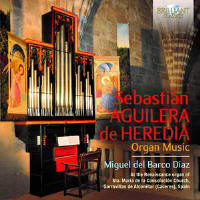Texte paru dans: / Appeared in: |
|
| Highly recommended. |
Outil de traduction ~ (Très approximatif) |
|
Reviewer: James
A. Altena
Sebastián Aguilera de Heredia (1561–1627) is yet another important Renaissance composer whose music had long slipped into oblivion but fortunately is now being revived. According to the concise but highly informative booklet notes by organist Miguel del Barco Diaz, Aguilera was the key figure in Spanish organ music between two now far more famous figures, Antonio de Cabezón (1510–1566) and Francisco Correa de Araujo (1584–1654), for whom I have reviewed multi-CD sets in 36:6 and 42:4. Virtually nothing certain is known about Aguilera aside from a very few career details. He was born, studied, and died in Zaragoza. It is speculated, but uncertain, that he may have studied under the important polyphonist Melchior Robledo (c. 1510–1586) and the organist Juan Ortiz (dates unknown), who preceded Aguilera as organist of the Catedral del Salvador in that city. Aguilera was ordained a priest in 1584, and from 1585 to 1603 served as principal organist of the Catedral de Huesca in Aragon, where he was given an increase in salary for exemplary performance of his duties. He assumed the position in Zaragoza in 1603 and held it until his death, overseeing a major renovation of the organ in 1605 that at his insistence incorporated half stops, which allow the organist to utilize two different stops with a single manual. The use of half stops is a prominent feature in Aguilera’s music; so too is the use of Spanish dance melodies. Stylistically, in contrast to the rapid rise in Italy of Baroque music as pioneered by Frescobaldi, with its emphasis on a harmonically supported main melodic line, the music of Aguilera and his colleagues in Spain remained much more rooted in medieval polyphony, with much more gradual incorporation of Baroque features. This disc presents all 18 of Aguilera’s surviving keyboard works (he also published a set of Magnificat settings in 1618). They are performed on the Renaissance organ of the Iglesia de Santa Maria de la Consolación, in the city of Garrovillas de Alconétar in the province of Cáceres, Spain. This small but lovely instrument with just 11 stops is the only surviving Spanish organ from Aguilera’s lifetime, dating from some time before 1578. . Miguel del Barco Diaz is a superb exponent of this music, drawing an enchanting array of colors out of the instrument and playing with impeccable style, being vivacious or tender as required. The proceedings are well recorded; the booklet also includes an artist bio, a brief note on the instrument, and two color photos. This disc is a lovely find; highly recommended.
| |
|
|
|
|
|
|
|
Cliquez l'un ou l'autre
bouton pour découvrir bien d'autres critiques de CD |
|




